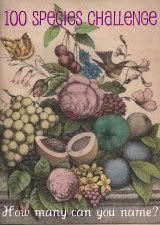I was over at the Charlotte Mason Blog Carnival at Jimmie's One Child Policy blog (well worth checking out even without the carnival) and found this entry:
Faith Alterton shares a most creative post at Blessed Quietness -- And yet another use for mud. That got your attention, didn't it?
Of course I had to check it out, and then I looked around and found the 100 species challenge.
What is the 100 Species Challenge you ask?
Well, it seems the person who came up with this challenge had read a book that mentioned most people nowadays cannot identify 100 species of plants within walking distance. So she took the challenge and has challenged others to do the same, identify 100 species of plants in your area.
You can do this on your own or you can blog about it. If you blog about it, these are the official rules.
The 100-Species Challenge
- Participants should include a copy of these rules and a link to this entry in their initial blog post about the challenge.
- Participants should keep a list of all plant species they can name, either by common or scientific name, that are living within walking distance of the participant's home. The list should be numbered, and should appear in every blog entry about the challenge, or in a sidebar.
- Participants are encouraged to give detailed information about the plants they can name in the first post in which that plant appears. My format will be as follows: the numbered list, with plants making their first appearance on the list in bold; each plant making its first appearance will then have a photograph taken by me, where possible, a list of information I already knew about the plant, and a list of information I learned subsequent to starting this challenge, and a list of information I'd like to know. (See below for an example.) This format is not obligatory, however, and participants can adapt this portion of the challenge to their needs and desires.
- Participants are encouraged to make it possible for visitors to their blog to find easily all 100-Species-Challenge blog posts. This can be done either by tagging these posts, by ending every post on the challenge with a link to your previous post on the challenge, or by some method which surpasses my technological ability and creativity.
- Participants may post pictures of plants they are unable to identify, or are unable to identify with precision. They should not include these plants in the numbered list until they are able to identify it with relative precision. Each participant shall determine the level of precision that is acceptable to her; however, being able to distinguish between plants that have different common names should be a bare minimum.
- Different varieties of the same species shall not count as different entries (e.g., Celebrity Tomato and Roma Tomato should not be separate entries); however, different species which share a common name be separate if the participant is able to distinguish between them (e.g., camillia japonica and camillia sassanqua if the participant can distinguish the two--"camillia" if not).
- Participants may take as long as they like to complete the challenge. You can make it as quick or as detailed a project as you like. I'm planning to blog a minimum of two plants per week, complete with pictures and descriptions as below, which could take me up to a year. But you can do it in whatever level of detail you like.
Because of 4-H wildlife this year, we do have a bit of a head start. This is going to be a fun challenge for us, and may make it easier to study for Wildlife contest next year, a contest that 8 & 9 year olds compete with highschool kids. To be honest, I am not quite sure who is at the disadvantage, LOL.
The first plants will be posted later today. Because of wildlife, and because I believe the original author complaining of the lack of botanical knowledge was referring to wild species, I am going to attempt to limit us to stuff we have not planted. For instance, I have a lovely rosemary bush but I know what rosemary is, I know what it does, etc.
I don't specify native because . . . there are many, many invasive plants that are non-natives, not just kudzu but also pretty things like honeysuckle, which would be useful to know more about. Also, to be honest, with plants you don't know, you don't know if they are native or not until you research them. I don't want us to research and then find out they are non-native and tell the kids "oops, we can't use this one." Besides on the wildlife contest there are non-natives like honeysuckle.
Any one else care to join me on this challenge?

















No comments:
Post a Comment